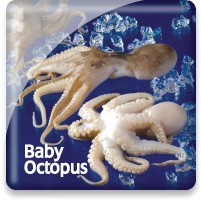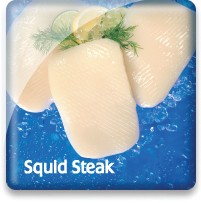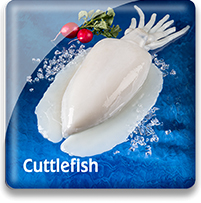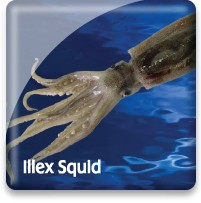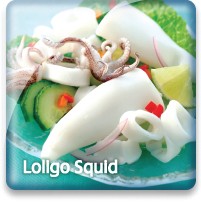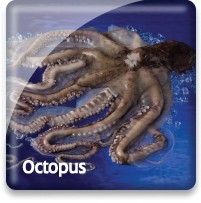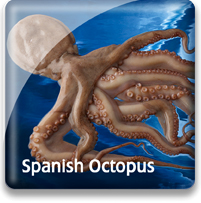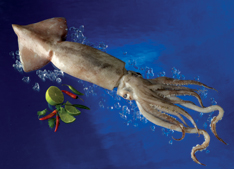
Arrow Squid

Market Name: Eating QualitiesSquid is a versatile product that is not strongly flavored, but considered by many to possess a kind of sweetness. The meat is tender and succulent. Frozen tubes should be ivory-white throughout and have no distinct odor.
   |
Description & CharacteristicsSquid, also called calamari, is a cephalopod mollusk with eight arms, two tentacles and a tubular shaped body that narrows to a point and has two fleshy wings along the rear part of the body. Squid swim tail-first by pumping water through valves located near their head. The shells have evolved into a small bone or pen inside the body. Like octopus and cuttlefish, they are cephalopods. There are many species in all seas, ranging in length from one inch to the Chilean giant squid of six feet and one hundred pounds. Even larger monsters are thought to live in very deep water. Squid grow fast and live only 12 to 14 months. Squid has excellent shelf life if handled with reasonable care. It is little affected by freezing, and the texture is unchanged even if the flesh is frozen and thawed a number of times. Fresh squid should have a sweet smell. It becomes rather pungent with age. Skin spots and color are not reliable guides to quality. The tentacles, wings and mantle (body) are all edible. There is a thin, soft skin covering the body and wings, which is usually removed before cooking. The skin changes color dramatically after the squid is caught. This is a natural process and is not a symptom of decomposition. Squid may be “bleached” by soaking it in iced water. This reduces the color changes and whitens the skin.Squid is processed into tubes, rings and strips. Steaks, circular pieces cut from the mantles of large squid and usually tenderized with a needle machine, are also produced as a retail trade alternative to expensive abalone steaks. Fried calamari has become a mainstay on many restaurant menus, which has contributed to an explosion in domestic usage. A great deal of squid is frozen whole for bait, used by both sport fishermen and commercial line fishermen.
Sea Port’s Premium Whole Arrow Squid is made to meet the needs of all restaurants whether white tablecloth establishments, sports bars or take-out operations. When you select our premium Nototodarus sloanii/gouldi varieties you will find a flavorful, tender offering ready for your recipes to please the most discerning palate of your guests.
The word “calamari”, often used for cooked squid, comes from the Greek work for “tube”.
Other Resources |
Handling Instructions for Arrow Squid
Arrow squid should be stored frozen at or below 0°F (-18°C) and then thawed properly when ready to cook. The frozen shelf life of our block frozen arrow squid is 24 months and 18 months for IQF. Links to proper seafood handling instructions: NOAA - Fish Watch: Handling Seafood and A Consumer Guide to Safe Seafood Handling.
Thawing Arrow Squid
Arrow squid should be thawed under refrigeration between 33°F and 39°F until it is completely thawed. The thawing time is dependent upon if the arrow squid is IQF or block frozen. IQF arrow squid will thaw within 24 hours and block frozen will take up to 48 hours or longer. Faster thawing can be accomplished by placing squid in a colander and running under cold water or by placing squid in a plastic bag and submerging in a cold water bath until thawed.
Important Instructions for Arrow Squid
Upon thawing arrow squid, clean and gently rinse with cold clean water. Thawed arrow squid should be used immediately or stored under proper refrigeration (33-39°F) and totally consumed in 1-2 days. Squid in general has a relatively short thawed shelf life.
Cooking Tips
Arrow Squid should be cooked very quickly to avoid becoming rubbery in texture (two minutes or less at high heat). If your recipe calls for a slow cook process or you want to include arrow squid in a seafood cioppino, then be sure to cook it for 20+ minutes to achieve tenderness. Link to cooking tips and recipes.
New Zealand
Long associated with lamb and wool production, high rugged mountains, and spectacular scenery, New Zealand is also a major seafood exporting country. While New Zealand produces only one percent of the world’s seafood, seafood is the country’s fifth largest export—destined for markets all over the world where the country’s excellent fisheries management has earned the “New Zealand” brand high marks for environmental sustainability and high quality.
The leading seafood products exported from New Zealand include Hoki, Squid, Greenshell™ Mussels, Rock Lobster, Orange Roughy, and Abalone. Key export markets for New Zealand are Japan, the USA, Europe, Hong Kong, Australia and Asia.
|
|
Go Blue! Seafood Sustainability Spectrum*Click here for an explanation of our Sustainability Spectrum 
Sustainability AssessmentThe Arrow Squid fishery takes place in New Zealand – a country known for having some of the best fisheries management in the world. There are two species of squid targeted in the New Zealand Arrow Squid fishery, Nototodarus gouldi and N. sloanii, which are managed in a single fishery. Management measures in place include an overall total allowable catch (TAC), with gear requirements (use of a sea lion excluder device) in certain areas. Landings have been less than the TAC of 127,332 mt each fishing year since 1997-98, fluctuating between 20,747- 86,075 mt. Part of the reason for catches remaining below the TAC in recent years is that management restrictions were placed on the trawl fishery around the Auckland Islands to mitigate New Zealand sea lion bycatch.Although relatively well managed, the arrow squid fishery is not without environmental concerns. Bycatch of sea lions and seabirds is a known conservation issue in the New Zealand squid fisheries, particularly in the Auckland Islands fishery. The New Zealand or “Hooker’s” sea lion population is listed as vulnerable on the International Union for the Conservation of Nature (IUCN) red list of endangered species because of a marked decline in pups born over the past decade. The New Zealand Ministry of Fisheries sets annual fishery related mortality limits which, when reached, are supposed to trigger a closure in the fishery. However, since mortality limits were initiated in 1991-1992, they have been exceeded in 8 fishing seasons. According to a government report, since 2004-05, “most of” the trawl fishery in the Auckland Islands has employed use of a sea lion excluder device (SLED), which is designed to allow sea lions to escape from a trawl net. However, estimated sea lion mortality has not declined substantially since introduction of the SLED in 2001-02, or its widespread use, which began in 2004-05.
Environmental Impact: ModerateStrong management is in place for arrow Squid, however, interactions with seabirds and sea lions are a known issue.
Sustainability Improvements NeededStricter enforcement of the fishery related mortality limits for New Zealand sea lions is needed. Potential improvements to SLED devices, with input from fishermen should also be encouraged to reduce sea lion mortality.
Actions that Sea Port is UndertakingSea Port is monitoring the eco-sustainability of this fishery as the New Zealand government strives to mitigate the ongoing harm to sea lions and birdlife. Recently, New Zealand has established a new licensing law for foreign vessels fishing in its waters that require that they adhere to the fair labor laws of New Zealand. Sea Port has restricted its sourcing of Arrow Squid to supplier vessels flagged under New Zealand or to foreign vessels that have been properly licensed under this new fair labor regulation. Sea Port believes that, in aggregate, choosing from a diverse variety of seafood is better for sustaining the world’s seafood resources and New Zealand Arrow Squid should be a part of this variety.
DeepWater Group | Sustainable Oceans - Sustainable Fisheries A Statement on NZ Quota Management System
|



